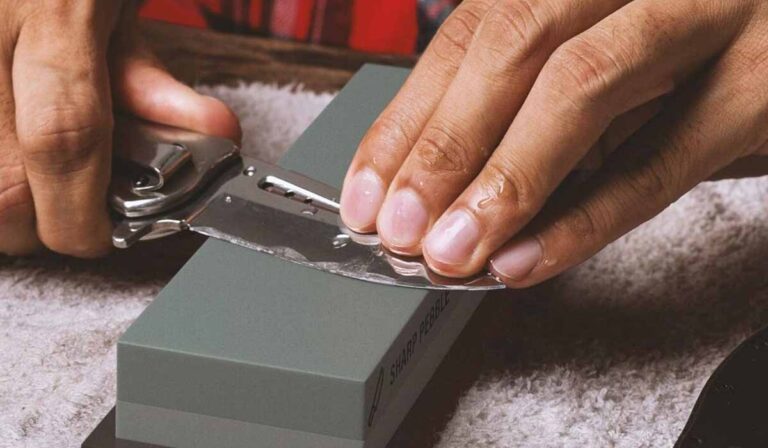
Delve into the art of honing perfect cutting edges with our comprehensive guide on some of the best sharpening stones available today.
Even the most expensive, well-made knife is only as good as its edge. You can have a blade made from an alloy of adamantium, vibranium, and uru (aka, the stuff in Wolverine’s claws, Captain America’s shield, and Thor’s hammer respectively) and it still won’t matter if it isn’t sharp.
And while a hardware store pull-through sharpener can get the job done in a pinch, especially if you don’t particularly care about the longevity of your knife, the best way to sharpen any blade is with a proper sharpening stone.
Which is what we’re going to talk about today.
We’re going to go over everything you need to know about sharpening stones, including all the different varieties (oil, water, diamond, and ceramic/glass), as well as how to choose based on your sharpening experience, and what type of knife or other sharp things you’re trying to make sharper.
We’ll also discuss things like grit size, and then we’ll dive into some reviews of the best sharpening stones on the market right now. Let’s start with the basics.
Types of Sharpening Stone
Oil Stones

Oil stones are some of the cheapest sharpening stones out there, and they do alright for softer steels, particularly for lower-end EDC knives, multi-tool blades, and other similar blades. They’re called oil stones because, as you probably guessed, you use oil with them.
This keeps the blade from catching on anything as you sharpen and helps keep the removed bits of nearly-microscopic metal from clogging too badly on the stone as you move the blade across it.
Available grits are a little limited with oil stones and tend to be a bit more coarse because the stones are made from aluminum oxide or silicon carbide. This means they aren’t great for knives with a highly polished finish, or for very tough knives made of modern “super steels”.
Water Stones
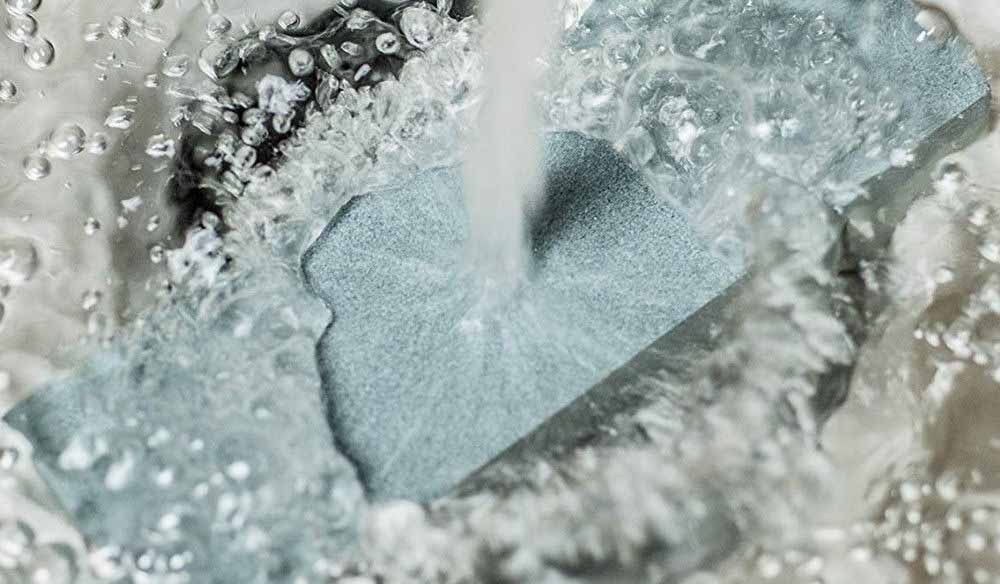
Water stones are another popular option that many people turn to to get a great edge on a blade, particularly kitchen knives, hunting/butcher knives, and other hard-use knives that require a sharp edge.
They’re called water stones because, as you probably guessed, they need to be wet in order to sharpen properly.
There are both natural and synthetic options available, with most natural water stones coming from central Europe or Japan, with the latter commanding a fairly high price due to its scarcity. These natural stones come in a range of grits, so there’s one for basically every need.
Synthetic water stones are more common (and less expensive) than their natural counterparts and are what you’ll find in most budget-friendly sets. Many of these stones will be dual-grit, with a coarse and fine side to make them a little more versatile.
Synthetic stones are generally very quick to use compared to their natural counterparts, but will occasionally need to be flattened with a special lapping plate in order to maintain a level top surface. This isn’t a difficult undertaking by any means, but it is worth keeping in mind.
Diamond Plates

Diamond sharpeners, also known as diamond plates or diamond stones, are fast becoming one of the more popular options for sharpening among blade-wielding professionals and anyone who demands a high-quality edge without a lot of fussing with a sharpening stone.
Diamond plates utilize a conductive nickel base with synthetic diamonds electroplated onto the surface. This leaves us with an incredibly durable sharpening surface that is unlikely to wear out in anything other than daily professional use.
If you’re a butcher, you might wear out a couple of these plates in your lifetime.
This durability is matched by their effectiveness, as most diamond plates work very quickly, can sharpen everything from very tough high-carbon steels to cheap stainless, and will even work well on tungsten and ceramic blades.
They’re relatively affordable given how long they last, with most high-quality options coming in under $75.
Arkansas Stones
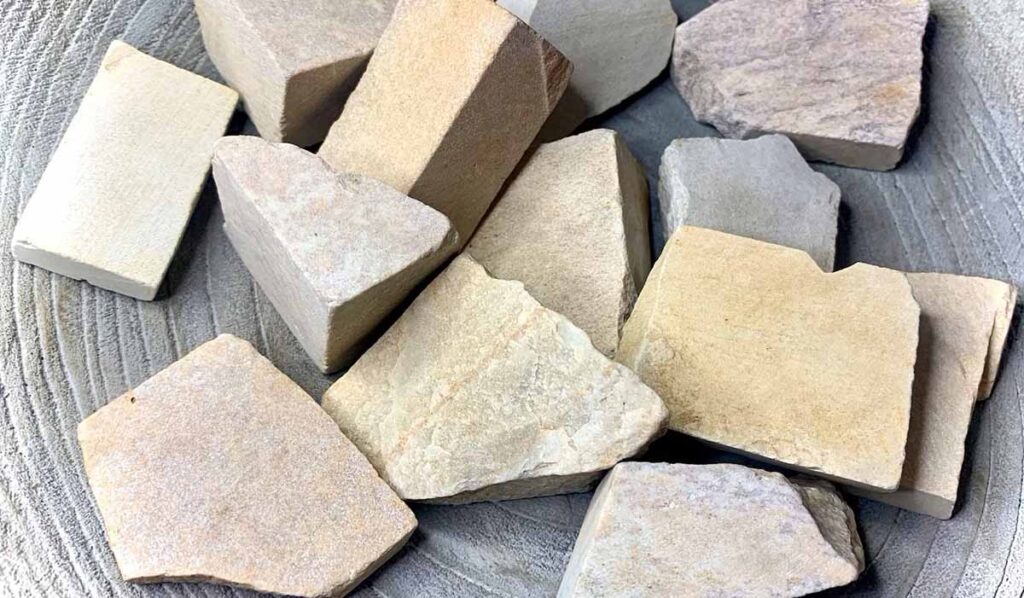
Lastly, Arkansas stones are worth mentioning because they’re often listed separately on many websites and they have some specific terms to know if you’re in the market for a sharpening stone.
As you might expect, Arkansas stones are a natural whetstone that is quarried in Arkansas (as well as Texas and Oklahoma) in the United States. This natural stone has been used since at least the 1800s as a sharpening stone and is also known as Novaculite, which comes from the Latin word for sharp knife or dagger.
Novaculite has also been quarried in Syria, Lebanon, Israel, and Japan, though these stones have a slightly different makeup and aren’t produced in great quantities anymore.
Many native peoples used the stone for arrowheads and other tools because of its hardness and density, and today it is a popular choice for natural whetstones. It has a long history in the US, and the first usage of the word “whetstone” was actually in reference to an Arkansas stone.
All that having been said, Arkansas stones are a great option but are really just a natural type of stone that can be used with oil or water.
Ceramic Sharpening Stones
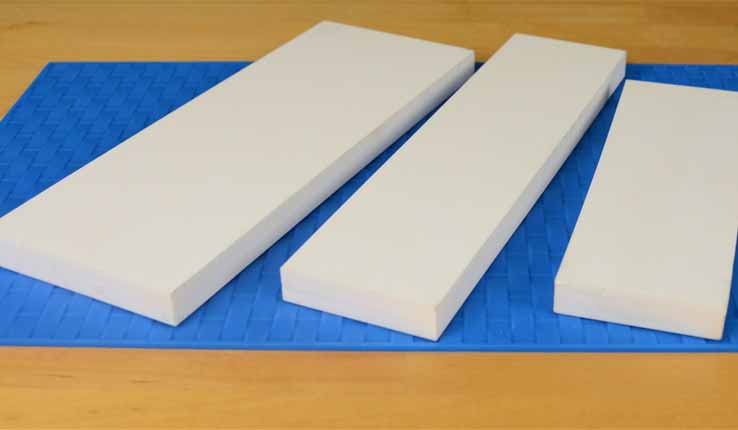
Ceramic sharpening stones are synthetic stones made of very accurately-sized grit particles bonded together to create one contiguous block. These stones, being man-made, are incredibly precise and durable, almost on par with diamond stones, but tend to be more expensive than natural stones.
Usually, these stones are made with corundum, which is an aluminum oxide that is commonly used in sandpaper, emery boards, and industrial abrasive applications. This makes the surface very hard indeed (a 9 on the Mohs scale, where a diamond is a 10) and thus great for sharpening.
Many ultra-fine grit stones will be some kind of ceramic-based product.
Grit Size: Bigger Really Isn’t Always Better
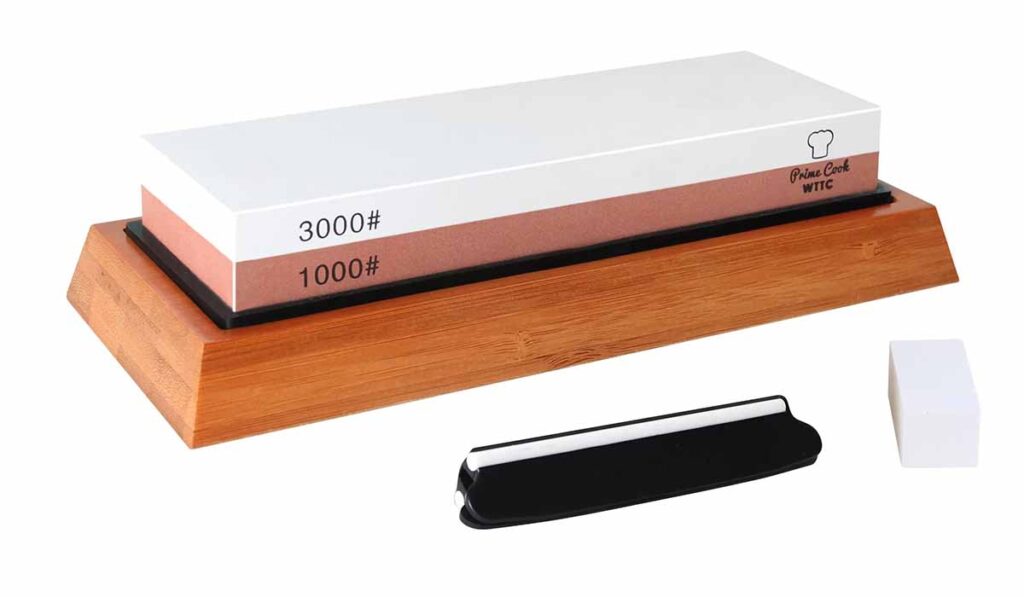
The first consideration, after you’ve chosen the type of sharpening stone (and we’re including diamond plates and synthetic ceramics in that) is going to be grit size.
The basic thing to remember is the lower the number associated with grit size the coarser the stone. We’re going to be using the JIS standard as that is what most folks in the US and Asia will be used to (sorry for our European readers, you may have to do some conversions).
The numbering system in the JIS system comes from the number of grit particles that will fit in a certain size square, so the smaller the number, the larger the individual grit particles will be.
These grits are then organized into ranges, typically Coarse, Medium, Fine, and Extra Fine or Finishing/Polishing stones.
- Coarse is anything under 1000 grit
- Medium is 1000 to 3000 grit
- Fine is 3000 to 5000
- Extra Fine is anything above 5000
This is just a general way to look at things though, and will vary from manufacturer to manufacturer. Some may call a 4,000-grit stone fine, and some may call it an extra fine, etc.
What you need to keep in mind is that the lower the grit, the more material you remove, so if you have a chip, rolled edge, or broken tip, then a grit of 1000 or below is appropriate. If you really need to restore an edge, pick up a coarse stone. Be careful though, as it’s easy to overdo it with these.
Most people find that a 1000- to 3000-grit stone (or dual-sided 1000 and 3000-grit combo stone) is a perfect option for keeping an edge on a pocket knife or other general sharpening tasks.
For the kitchen, I personally find that a 5000 grit is great for cleavers and butcher knives, and a 6000-8000 is great for knives with duties such as thinly slicing soft vegetables. I have a 1000/6000 grit combo stone that I find very useful for quickly restoring an edge and getting it back to where I want it.
For my woodworking chisels, I typically go from 4000 to 8000, but for finer work, I can definitely see the need to go to 10,000 and beyond for a truly polished edge, especially if you’re a better woodworker than I am (which is a low bar).
Speaking of Size, Make Sure Your Stone is Big Enough
Most sharpening stones are standardized at around 7-inches long, and 3-inches wide which is perfect for most kitchen knives and pocket knives, but make sure you check the face dimensions so you know what you’re getting.
If you’re going to be sharpening something like a carving knife, machete, or sword, a lot of times you’ll want something a bit larger just so you can get more of the edge at once.
Well-Dressed Stones Last Longer
No, we’re not talking about putting your whetstones in a little suit. Dressing a stone refers to flattening the top surface out so that it makes even contact with the edge that you’re sharpening. Sharpening stones wear more towards the middle part of the face, which is known as “dishing”.
To correct this, stones need to be “dressed” or flattened so that they have a nice, even surface for sharpening. This is especially an issue if you use your stones a lot, or use them on lots of fairly short knives.
To fix this, a dressing plate is used to correct the issue and resurface the top of the stone. This can help your stone last much longer, and give you much more even results.
Buyer’s Guide: Best Sharpening Stones on the Market Today
Sharp Pebble Premium Whetstone
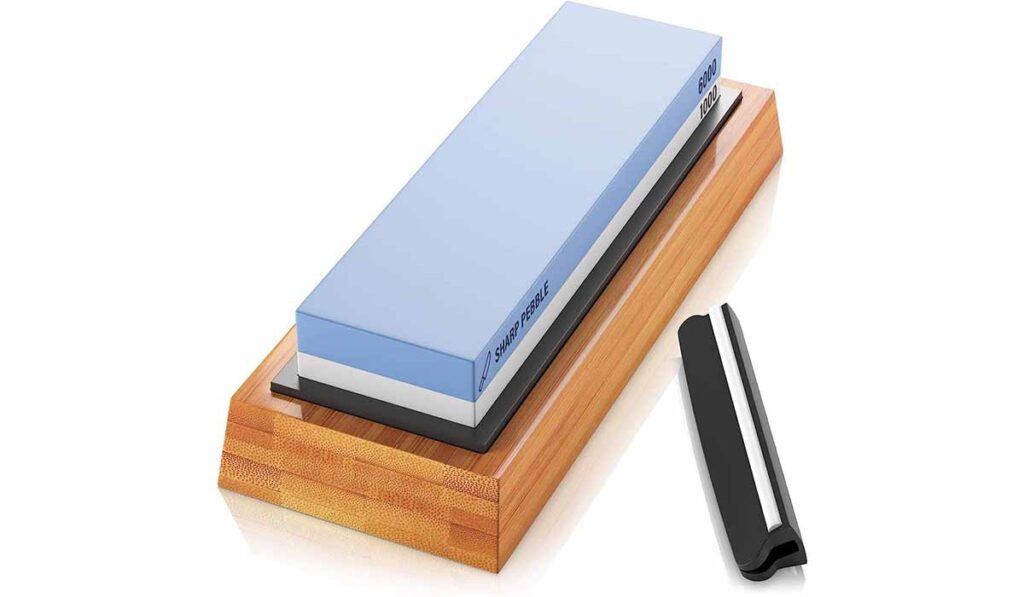
First up, we have one of my go-to sharpening stones, the Sharp Pebble Premium Whetstone, in particular this 1000/6000 combo stone. Sharp Pebble does a great job sourcing all its stones, and if you’re just looking to keep your kitchen knives in the right condition, this is where I’d start.
This is an aluminum oxide-based stone that offers a course and fine edge so you can quickly get a decent edge back, then polish up the edge to get something that can easily handle everything from butchering a deer to shaving depending on how much time you spend with the 6000 grit side.
It comes with a bamboo base with a non-slip bottom and a silicone—gasket? holder? grippy thing?—for the stone that keeps it from sliding around or messing up the nice bamboo base. It also includes a 20-degree angle guide to help you get the angle right.
The fact that you get two very useful grits in one stone, plus the base and angle guide makes this a great option for anyone who is making the jump to sharpening with a whetstone instead of a pull-through sharpener. If you’re looking to learn, this is a great place to start.
This, plus a strop could easily be all you ever really need if you’re just looking to keep a good edge on your EDC or home kitchen knives.
Diamond Machining Technology 8-inch DuoSharp

Stepping up a little bit, we have the DMT DuoSharp, which is a large, dual-grit diamond plate that is great for everything from pocket knives to chisels, and will likely last through a decade or more of regular use.
Because this is a diamond surface, it won’t wear away towards the middle or “dish” like an actual stone will, and it will work well without oil, allowing you to sharpen dry or with water if you prefer.
The size makes it a great option for a workshop bench, and I’ve personally used mine on everything from a rusty machete left in the bottom of a sailboat, to my chisels and other woodworking tools that required a touched up.
You can definitely use this for kitchen and pocket knives as well, and the coarse/fine stone will work well for most people. If you’re restoring old tools or putting an edge on a splitting maul or something, the extra coarse/coarse stone might be a better option for removing lots of material quickly.
Naniwa Abrasive 3,000 Grit Stone

Now we step into the world of natural sharpening stones with a Japanese stone that is a little on the expensive side, but worth every penny if you want a long-lasting stone that will be easy to use and put a great edge on any blade.
Naniwa Abrasive is a major name in natural sharpening stones, and their standard 3,000 grit stone is a great starting point for anyone looking to upgrade their sharpening game a little bit. I got one of these years ago when I wanted a good medium grit stone for my kitchen knives, and it has been a great performer.
If you’re like me and don’t really let your knives get super dull to the point where you need a 1000-grit stone, and also don’t often spend hours sharpening to a mirror finish, this is a great option for a usable, functional edge on most any knife, especially one that you actually plan to use.
Whetstone Cutlery 400/1000 Wet Block
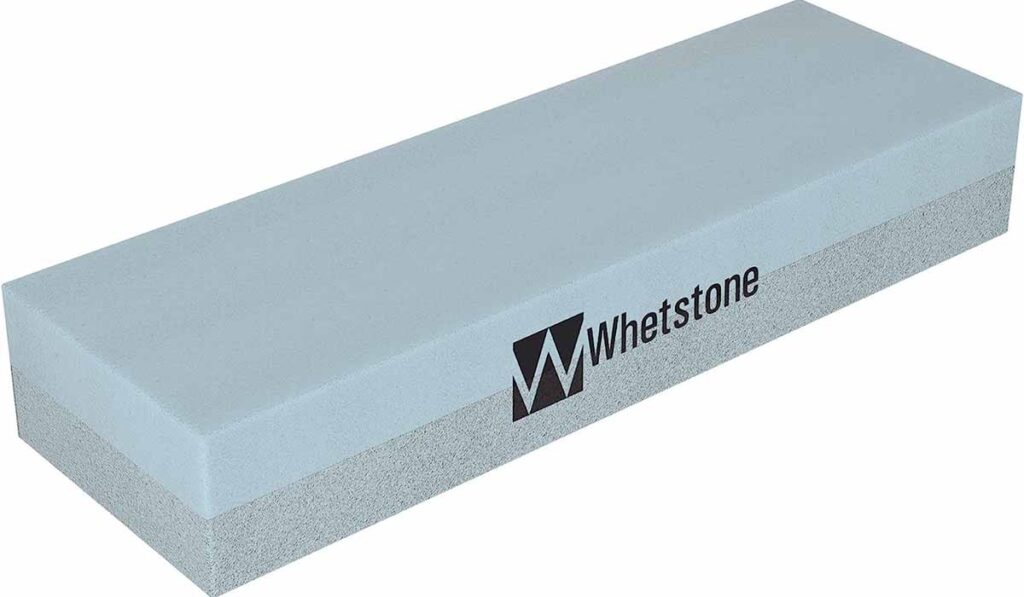
If the blade you’re sharpening is less “master-forged Nippon steel katana” and more “machete that’s been sitting out in the woods” then you’re probably going to want a very coarse stone to get it back to a decent starting point.
For that, we like this very simple and affordable 400/1000 stone from Whetstone Cutlery. It’s cheap and cheerful, and more than capable of getting an edge back on even the dullest of knives.
The 400-grit side will remove rust and take out nicks and chips in an edge, and then the 1000-grit side will help you bring it back to something resembling a real blade edge before you start working on it with higher grits.
Unless you’re restoring old tools, you might not ever need such an aggressive stone, but having one on hand for getting that rusty plane back in working order isn’t a bad idea. And it’s cheap enough that even if you only break it out a couple of times a year, you’ll get your money’s worth.
I really enjoy restoring old Case and Victorinox knives that have been used and abused for years, and this is the perfect stone for repairing those flea market finds, even if someone has snapped the tip of the blade off while trying to use it as a screwdriver or something.
Nanohone Superbite Whetstones
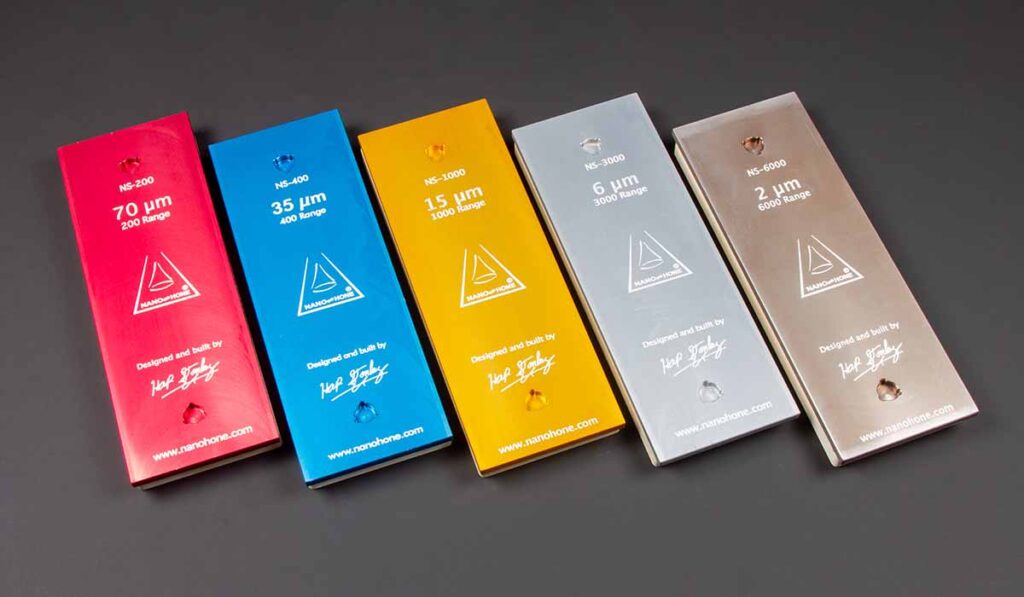
Nanohone’s Superbite “Splash and Go” stones are incredibly high-quality, non-porous ceramic sharpening stones that are simple and quick to use.
They’re also incredibly expensive for a whole set of seven, with individual stones costing around $70.
Still, if you’re looking for a high-end sharpening stone set that will work on everything from your beat-up old pocket knife to your fancy Japanese kitchen knives, this is a great option. The stones themselves come in every grit from 70 microns (200 grit) to 1 micron (10,000 grit) so there’s something for every sharpening and polishing need here.
The stage and sharpening ponds are sold separately, so you can mix and match stones and get exactly what you need without spending too much money. If you enjoy sharpening itself as a hobby and want a kit that can grow as you grow your skills, this is a great option.
Tojiro Pro Finishing Whetstone
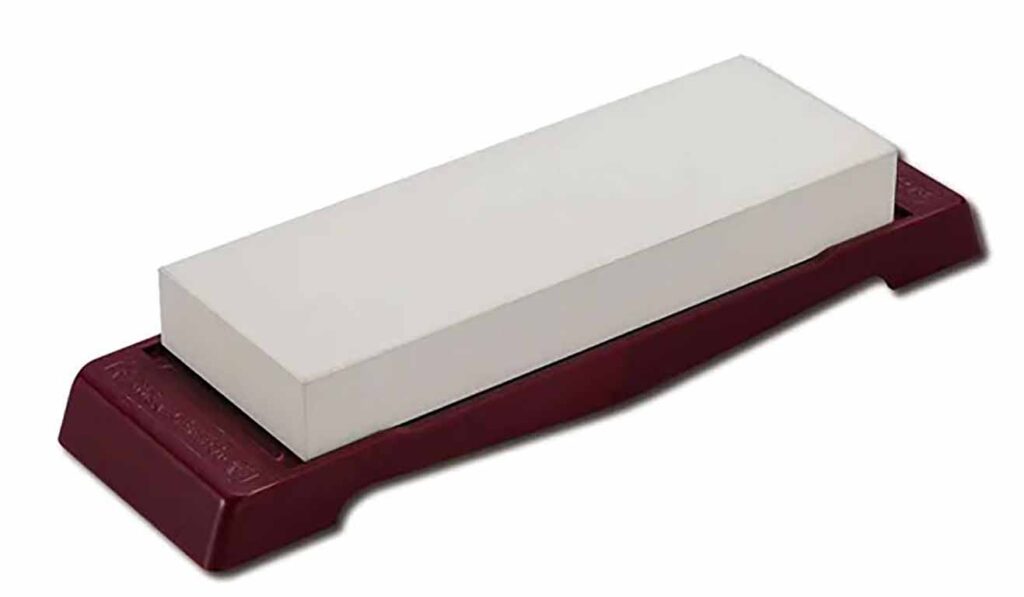
Lastly, we have this high-grit ceramic stone from the Japanese maker Tojiro. These are laser-sintered ceramic, which is great for any ultra-fine applications where you need to get a razor edge.
If you treat sharpening as part of your craft and need professional-grade tools, this is a great option whether you’re a chef, barber, woodworker, or you’re just passionate about having incredibly sharp knives.
Tojiro is primarily a maker of incredibly nice kitchen knives, so you’d probably expect them to know what they’re doing when it comes to sharpening. Their Pro line was originally made for their in-house artisans, and now they’ve made them available to the public as well.
If you want to get a great edge on any knife, particularly high-end, super steel knives, then this is a great option if you have the money to spend.
Final Thoughts on Sharpening Stones
A knife truly is only as good as its ability to cut, which makes a good quality sharpening stone (or stones) a key tool in any blade aficionado’s arsenal. Whether you carry a simple pocket knife, are passionate about cooking, or work with edged tools like chisels, planes, and axes, you need a way to achieve a good edge.
With these sharpening stones, you can get the performance out of your EDC knife you’ve always wanted, get those paper-thin slices of tomato when you’re in the kitchen, and get just the right edge on those tools at work.
Just remember to go slowly, especially at first, choose the right stone with the right grit, and you’ll have razor-sharp edges in no time.
More Sharpening Articles:- Knife Sharpening: What’s the Best Angle?
- 5 Myths About Knife Sharpening
- 5 Leading Sharpening Rods
- 4 Steps to Perfect Freehand Sharpening
 NEXT STEP: Download Your Free KNIFE GUIDE Issue of BLADE Magazine
NEXT STEP: Download Your Free KNIFE GUIDE Issue of BLADE Magazine
BLADE’s annual Knife Guide Issue features the newest knives and sharpeners, plus knife and axe reviews, knife sheaths, kit knives and a Knife Industry Directory.Get your FREE digital PDF instant download of the annual Knife Guide. No, really! We will email it to you right now when you subscribe to the BLADE email newsletter.







What a detailed and insightful article! It’s always beneficial to know that good sharpening stones can drastically enhance the performance of our beloved kitchen tools. A sharp knife isn’t just about making cooking easier — it also greatly increases our safety during meal preparation.
The ability to make precise cuts with minimal effort is truly game-changing in the culinary world. Plus, routine knife maintenance preserves the lifespan of our tools and thus maximises our investment. For anyone interested, a fantastic site that offers sharpening and restoration services https://www.justknives.com.au/ is Just Knives. They truly understand the myriad implications of a good, sharp knife.
And how ingenious are these synthetic water stones with their dual-grit capability? Allowing for versatility and adaptability to different knife types and their unique requirements. It’s comforting to know that cooking with a dull knife is a thing of the past. A well-sharpened knife clearly does more than just slicing — it enhances the joy of cooking!